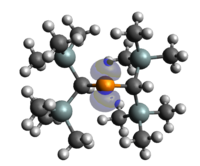
Photo from wikipedia
In combination with EtAlCl2, complexes {[WCl3(μ-Cl)(N-2,6-iPr2C6H3)]2}, [WCl4(NR)(thf)] (R = Et, iPr, cHx, Ph, 2,6-iPr2C6H3, 4-F-C6H4, and 2,4,6-F3-C6H2), and [WCl2(NR′)(PMe3)3] (R′ = Ph, 2,6-iPr2C6H3) were all productive ethylene dimerization pre-catalysts, giving… Click to show full abstract
In combination with EtAlCl2, complexes {[WCl3(μ-Cl)(N-2,6-iPr2C6H3)]2}, [WCl4(NR)(thf)] (R = Et, iPr, cHx, Ph, 2,6-iPr2C6H3, 4-F-C6H4, and 2,4,6-F3-C6H2), and [WCl2(NR′)(PMe3)3] (R′ = Ph, 2,6-iPr2C6H3) were all productive ethylene dimerization pre-catalysts, giving turnover numbers (TONs) in the range of 400–144 000 (mol C2H4)(mol W)−1 and moderate selectivities toward 1-butene (>66%) depending on the nature of the imido substituent. The formation of C6 side-products resulted from the incorporation of 1-butene rather than direct trimerization, something that is independent of butene concentration. Stoichiometric reactions between the tungsten mono(imido) complexes and alkylaluminum reagents are described, which are consistent with the reduction of the tungsten centre playing an important part in the initiation process. Testing discrete WV and WIV mono(imido) complexes for olefin dimerization revealed the former to be significantly more active, which offers insight into the mode of action of the commercial...
Journal Title: ACS Catalysis
Year Published: 2018
Link to full text (if available)
Share on Social Media: Sign Up to like & get
recommendations!